Learn about the best peony companion plants to help this lovely perennial thrive. Get a list of the best companion plants you can surround your peonies with, including the best flowers to grow as companion plants for peonies, the best fruit to plant around peonies, the best herbs to plant with peonies, and the best vegetables to plant with peonies. Get ideas about which plants to avoid planting near peony plants as well. You will also learn about the best time to plant peonies, the best place to plant peonies, how to support peonies as they grow, the best fertilizer for peonies, the watering needs of peonies, and the best way to propagate peonies to increase the number of your peony plants. You will also find a handy quick reference chart that lists all of the peony companion plants in one place. Let‘s get started!
This post contains affiliate links, which means I may earn a small commission from qualifying purchases at no additional cost to you. Please read my Policies page for more information.
Table of Contents
Why I Love Peonies
Years ago, my dear, sweet, late mother-in-law divided her peonies and gave us some starts. Every year when they return, I am reminded of her and the way she would always encourage me. Her favorite color was pink, and the different varieties she gave us reflect her love of gardening.
Peonies make great cut flower bouquets, and are a colorful addition to our front yard, as well as in other spots around our landscape. They bloom reliably each year. Some people might be bothered by the fact that they require staking for support, but the staking process does not take much time (see below for some tips). It’s a small price to pay for the beauty that peonies provide.
What Makes a Good Companion Plant?
Why pay attention to companion plants? A good companion plant is one that offers various benefits to its neighboring plants, such as minimizing pest and disease issues, which helps enhance their growth, health, and overall productivity. Here are some key qualities that make a good companion plant that will help you plant strategically to make the most of your yard or garden space:
Pest Control: Companion plants may repel pests or attract beneficial insects that prey on pests, helping to reduce pest damage without the need for chemical pesticides.
Pollinator Attraction: Plants that attract pollinators such as bees, butterflies, and hummingbirds can improve pollination and fruit set in neighboring plants, leading to higher yields.
Soil Improvement: Some companion plants have deep roots that help break up compacted soil, while others fix nitrogen or add organic matter to the soil, improving soil fertility and structure for neighboring plants.
Complementary Growth Habits: Companion plants with different growth habits, such as tall plants providing shade for shorter ones or ground covers suppressing weeds, can maximize space and resources in the garden.
Disease Resistance: Certain companion plants may emit chemicals or compounds that inhibit the growth of pathogens or pests, reducing the risk of disease in neighboring plants.
Seasonal Considerations: Companion plants that thrive during different seasons can provide continuous benefits throughout the year, such as early bloomers attracting pollinators or cover crops protecting soil during the off-season.
Aesthetic Value: Companion plants with attractive foliage, flowers, or fruits can enhance the visual appeal of the garden while providing practical benefits to neighboring plants.
What is a Peony?
A peony is a flowering perennial plant native to Asia, Europe, and North America. It belongs to the genus Paeonia and is prized for its large, showy blooms in a wide range of colors, including white, pink, red, and yellow. Peonies come in several types, including herbaceous peonies (which is what we have, pictured above), tree peonies, and intersectional peonies, each with its own unique characteristics and growing requirements. They are popular garden plants, valued for their beauty, longevity, and low maintenance.
Peonies typically bloom in late spring to early summer, depending on the variety and location. In most temperate climates, this usually occurs from late April to early June. Some peonies are prized specifically for their delightful scent. When choosing peonies for fragrance, look for varieties such as ‘Karl Rosenfield’, ‘Shirley Temple’, ‘Sarah Bernhardt’, ‘Festiva Maxima’, ‘Coral Charm’, and ‘Bowl of Beauty’, among others.
Peony Companion Plants: Flowers
Here are some of the best companion flowers for peonies. Each of these companions enhances the visual appeal of peonies while sharing similar growing conditions, making for a cohesive and beautiful garden display. We have most of these growing in our yard and garden:
Irises: Irises bloom around the same time as peonies and add height and structure to the garden with their tall, elegant flowers. Their sword-like foliage also complements the lushness of peony leaves.
Lupines: Lupines provide vertical interest with their tall, spiky blooms and come in a variety of colors that can enhance the peonies’ palette. They also improve soil quality by fixing nitrogen.
Columbines: These delicate, airy flowers offer a nice textural contrast to the large, dense peony blooms. They thrive in similar conditions and add a whimsical touch to the garden.
Alliums: Alliums’ spherical blooms create a striking visual contrast to peonies. Their tall, sturdy stems and unique flower heads add architectural interest to the garden.
Roses: Roses are classic companions that add continuous blooms and a lovely fragrance to the garden. Their varied colors and forms can complement peonies beautifully.
Bleeding Hearts: These plants bloom at the same time as peonies and add a romantic, old-fashioned charm with their heart-shaped flowers. Their arching stems provide a graceful contrast to peonies.
Foxgloves: Foxgloves offer vertical interest and their bell-shaped flowers provide a dramatic contrast to peonies. They also attract pollinators, benefiting the overall garden ecosystem.
Peony Companion Plants: Fruit
Companion planting fruit with peonies can create a productive and aesthetically pleasing garden. Here are some of the best companion fruits for peonies:
Strawberries: Strawberries have a low-growing habit that can act as a ground cover, helping to suppress weeds around peonies. Their small, white flowers complement the large, colorful blooms of peonies, and they benefit from similar soil and sunlight conditions.
Blueberries: Blueberries provide beautiful, bushy foliage that contrasts nicely with peonies. They also bloom in spring, adding more seasonal interest. Both peonies and blueberries thrive in well-drained, slightly acidic soil.
Raspberries: Raspberries can be planted at the back of a peony bed, as they grow taller and won’t overshadow the peonies. They provide vertical interest and the canes can offer a natural support for peony stems.
Currants: Currants are compact bushes that won’t compete with peonies for space. Their ornamental foliage and small, attractive berries add visual interest throughout the growing season. They also thrive in similar soil conditions.
Gooseberries: Gooseberries, like currants, are small shrubs that complement peonies well. They provide a lush background and their berries add a pop of color to the garden.
Peony Companion Plants: Herbs
Companion planting herbs with peonies can create a diverse and thriving garden. Here are some of the best companion herbs for peonies:
Lavender: Lavender’s fragrant, purple blooms contrast beautifully with peonies and help deter pests. Its drought-tolerant nature and preference for well-drained soil align well with peonies’ needs.
Thyme: Thyme is a low-growing herb that serves as a ground cover, helping to suppress weeds around peonies. Its small flowers attract beneficial insects and add a subtle fragrance to the garden.
Sage: Sage’s textured leaves and tall spikes of flowers provide a striking contrast to the lushness of peonies. Sage also repels certain pests, which can benefit peony health.
Chives: Chives produce attractive purple flowers and their upright, grassy foliage complements peonies. They also have natural pest-repelling properties, particularly against aphids.
Oregano: Oregano spreads easily, covering the ground and reducing weed competition. Its tiny flowers attract pollinators and beneficial insects, enhancing the overall garden ecosystem.
Rosemary: Rosemary’s woody stems and needle-like leaves offer a unique textural contrast to peonies. Its fragrance deters pests, and it thrives in similar well-drained soil conditions.
Peony Companion Plants: Vegetables
Companion planting vegetables with peonies can create a beautiful and functional garden. Here are some of the best companion vegetables for peonies:
Lettuce: Lettuce has a low-growing habit that won’t compete with peonies for space or light. It can help suppress weeds and its cool-season growth cycle complements the peonies’ blooming period.
Spinach: Similar to lettuce, spinach grows low to the ground and thrives in the cooler temperatures of spring, coinciding with peonies’ blooming season. Its dense foliage can help keep the soil cool and moist.
Radishes: Radishes grow quickly and can be harvested before peonies fully leaf out, making them a good early-season companion. Their fast growth also helps break up soil, improving aeration.
Carrots: Carrots have deep roots that can improve soil structure and aeration around peonies. They grow well in the same loose, well-drained soil that peonies prefer.
Bush Beans: Bush beans can provide a light shade that benefits peonies during the hottest part of the summer. They also fix nitrogen in the soil, which can improve soil fertility for peonies.
Beets: Beets have a compact growing habit and their colorful leaves add visual interest. They also grow well in the same well-drained soil conditions as peonies.
What Not to Plant with Peonies
When planning a garden with peonies, it’s important to avoid planting the following with peonies:
Large Trees and Shrubs: Their roots can compete with peonies for nutrients and water. Additionally, their shade can hinder peony growth, as peonies prefer full sun. Right now in our yard, we have a peony that is being overshadowed by a maple tree, and it has definitely affected the growth.
Ground Covers: Plants like vinca, ivy, or other aggressive ground covers can overtake peonies, competing for space, nutrients, and water. The peonies in our yard that are thriving are the ones that have some space around them that is just covered with bark chips, not a groundcover plant.
Tall, Dense Plants: Tall plants that create significant shade or have dense foliage, like large ornamental grasses or tall perennials, can overshadow peonies, limiting their access to sunlight.
Plants with Different Soil Preferences: Avoid plants that require significantly different soil conditions, such as very acidic or waterlogged soil, like cattails or Japanese iris, since peonies prefer well-drained, slightly acidic to neutral soil.
Heavy Feeders: Plants that require a lot of nutrients, such as certain vegetables or heavy-feeding annuals, like tomatoes, can deplete the soil, making it less favorable for peonies.
Peony Companion Planting Chart
| Peony Companion Plants | |
| Peony Companion Plants: Flowers | Peony Companion Plants: Fruit |
| Alliums | Blueberries |
| Bleeding heart | Currants |
| Columbine | Gooseberries |
| Foxgloves | Raspberries |
| Irises | Strawberries |
| Lupines | |
| Roses | Peony Companion Plants: Herbs |
| Chives | |
| Peony Companion Plants: Vegetables | Lavender |
| Beets | Oregano |
| Bush beans | Rosemary |
| Carrots | Sage |
| Lettuce | Thyme |
| Radishes | |
| Spinach | Worst Peony Companion Plants |
| Cattails | |
| Ivy | |
| Japanese iris | |
| Large trees | |
| Ornamental grasses | |
| Vinca | |
Peony Planting and Growing Tips
When to Plant Peonies
The best time to plant peonies is in the fall, typically between late September and early November. This allows them to establish their roots before the ground freezes and ensures strong growth in the spring.
Where is the Best Place to Plant Peonies?
The best place to plant peonies is in a sunny location with well-drained soil. They need at least 6 hours of direct sunlight daily and benefit from being in a spot with good air circulation to prevent disease. Peonies should be planted 3 to 4 feet apart to allow for their mature size and to prevent overcrowding, which can lead to disease and poor flowering.
What is the Best Fertilizer for Peonies?
The best fertilizer for peonies is a balanced, slow-release fertilizer with a formula such as 10-10-10 or 5-10-10. Apply it in early spring as new growth emerges, following package instructions for dosage. Avoid high-nitrogen fertilizers, as they can promote leafy growth at the expense of flowers.
How to Support Peonies
Supporting peonies helps prevent their heavy blooms from drooping or falling over. Here’s a brief guide on how to support peonies:
Install Supports Early: Place supports early in the spring as the peonies start to grow, so the stems grow through them naturally. If we wait too long to support our peonies, the rain will cause them to droop. Once that happens, it’s tougher to place the supports around the plants. We have learned the hard way.
Positioning: Ensure the supports are centered around the plant to evenly distribute support as the peony grows.
Adjust as Needed: As the plant grows, adjust the supports to ensure the blooms and stems are well-supported and not restricted.
Examples of materials and supplies you could use to support peonies include:
Peony Rings: Circular metal or plastic supports with grid-like tops.
Grow-Through Grids: Metal grids placed over plants, allowing stems to grow through.
Plant Stakes: Individual stakes placed around the peony with twine or plant ties creating a supportive ring. This is what we use, pictured in the wheelbarrow above.
Bamboo Stakes: Natural, lightweight stakes that can be used similarly to plant stakes.
Twine, Stretch Tie Tape, or Plant Ties: Used to secure stems to stakes or create a supportive net around the plant. This is also pictured above in the wheelbarrow.
Here is what a supported peony looks like in our garden after staking. We usually place three stakes around each plant.
How Much Water Do Peonies Need?
Peonies need about 1 inch of water per week, either from rainfall or supplemental watering, especially during dry periods. Ensure the soil remains moist but not waterlogged.
What are Common Peony Pests and Diseases?
Common pests and diseases affecting peonies include:
Botrytis Blight: This fungal disease causes gray mold on flowers and stems, particularly in humid conditions. To prevent it, avoid overhead watering, provide good air circulation, and remove infected plant debris.
Powdery Mildew: Powdery mildew appears as a white, powdery substance on leaves and stems. Improve air circulation and avoid overcrowding plants.
Peony Wilt: This fungal disease causes black spots on stems and wilted foliage. Cut and remove infected plant parts and ensure proper drainage.
Nematodes: These microscopic worms can damage peony roots, leading to stunted growth and poor flowering. Plant nematode-resistant varieties and improve soil drainage to reduce nematode populations.
Peony Leaf Blotch: This bacterial disease causes dark spots on leaves. Remove and destroy infected foliage and avoid overhead watering. Peony leaf blotch has affected our plants, mainly due to rainfall here in our damp Pacific Northwest climate. We try to avoid overhead watering, but we can’t help the rain. Leaf blotch is just something we have to look out for and manage as best we can.
Propagating Peonies
The best way to propagate peonies is through division. This is typically done in the fall when the plant is dormant. Dig up the clump, divide it into sections with healthy roots and at least one bud, and replant them in prepared soil.
Pruning Peonies
Pruning peonies involves a few simple steps to ensure healthy growth and abundant blooms in the following season:
Pruning Steps:
Deadheading: After the peonies bloom, remove spent flowers by cutting the stem just above the first set of healthy leaves. This prevents the plant from wasting energy on seed production.
Fall Cleanup: In late fall, after the first frost has killed the foliage, cut the peony stems down to about 1-2 inches above the ground. This helps prevent disease and prepares the plant for winter dormancy.
Dispose of Debris: Remove and dispose of all cut foliage and stems to reduce the risk of disease and pests.
Here are some tools that will make pruning easier:
Sharp Pruners or Scissors: For clean cuts without damaging the plant. Our favorites are made by Felco.
Gloves: To protect your hands while pruning.
Peony Varieties
There are three main types of peonies: herbaceous peonies, tree peonies, and intersectional peonies (also known as Itoh peonies). Herbaceous peonies are the most common type, with soft, herbaceous stems that die back to the ground in winter. They bloom in spring and come in a wide range of colors. This is the kind of peony that we have.
Some specific varieties of herbaceous peonies include:
Sarah Bernhardt: Known for its large, fragrant, pink double blooms.
Festiva Maxima: Recognized for its large, white flowers with crimson flecks.
Coral Charm: Noted for its striking coral-pink blooms that fade to a soft peach color.
Bowl of Beauty: Loved for its unique bowl-shaped, pink flowers with a creamy center.
Karl Rosenfield: Appreciated for its deep crimson, semi-double blooms and sturdy stems.
Red Charm: Renowned for its huge, double, deep red flowers that are nearly black in bud.
Shirley Temple (pictured above): Admired for its delicate, blush-pink, double blooms with a soft fragrance.
Tree peonies have woody stems that persist year-round and often have larger, more exotic flowers. They bloom earlier than herbaceous peonies and can be more tree-like in growth habit.
Intersectional peonies (Itoh peonies) are hybrids between herbaceous and tree peonies. They have the sturdy stems of tree peonies and the large, colorful flowers of herbaceous peonies.
Need More Planting Ideas?
Check out the tips for the best companion plants for eggplant to learn what to grow with those beauties. If you like the idea of companion planting, you might be interested in reading about the best companion plants for pumpkins, sunflowers, garlic, asparagus, rosemary, radishes, beetroot (beets), thyme, parsley, lupine, borage, stevia, kale, or the best companion plants for lavender. Get tips for growing stunning dahlias or vintage roses. Are you a beginning gardener? Try planting some foolproof, easy-care perennials, or learning about the best companion plants for columbine. There are so many exciting plants to grow!
Keep Track of Your Garden with a Journal Logbook
Now that you have learned about some compatible companion plants, keep track of your planting ideas, goals, and plans with a printable, editable free garden journal logbook. Choose the pages you want to use and customize them as you wish to record monthly, weekly, and daily garden tasks, lists, weather, and planting arrangements. There are also grid pages for easily designing the layout of your vegetable garden, flower garden, or landscape. Print it out and put it into a notebook you can take with you to the garden (that’s what I do). It’s nice to have all of your garden information in one place.
Get the garden journal logbook!
Free Online Garden Planner Layout Template
Now that you know which are the best companion plants for peonies, you might need a way to plan your garden layout. Whether you are planting vegetables, flowers, or herbs near your lupine plants, this online garden planner can help you visualize your design and bring it to life. Arrange and rearrange the plants over and over, then print the layout when you are satisfied. With garden tasks that need your attention, this is one way to save time.
It’s fully customizable when you make your own copy and includes two editable chart pages for noting planting specifications.
Get my free online garden layout planner template!
Have a wonderful week, and may all of your peony-growing endeavors meet with success!

Lisa Mitchell is a wife, mom, and school librarian who likes to grow fruit, herbs, vegetables, and flowers on her family’s small Pacific Northwest farm. To learn more about what this website has to offer gardeners, click on over to the Garden page.
Want more great garden, food, or travel ideas? Follow FluxingWell on Pinterest, Flipboard, Facebook, Instagram, and X for the latest posts, tips, and inspiration.

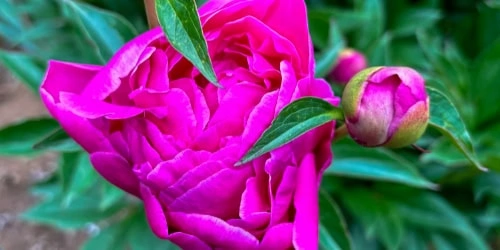

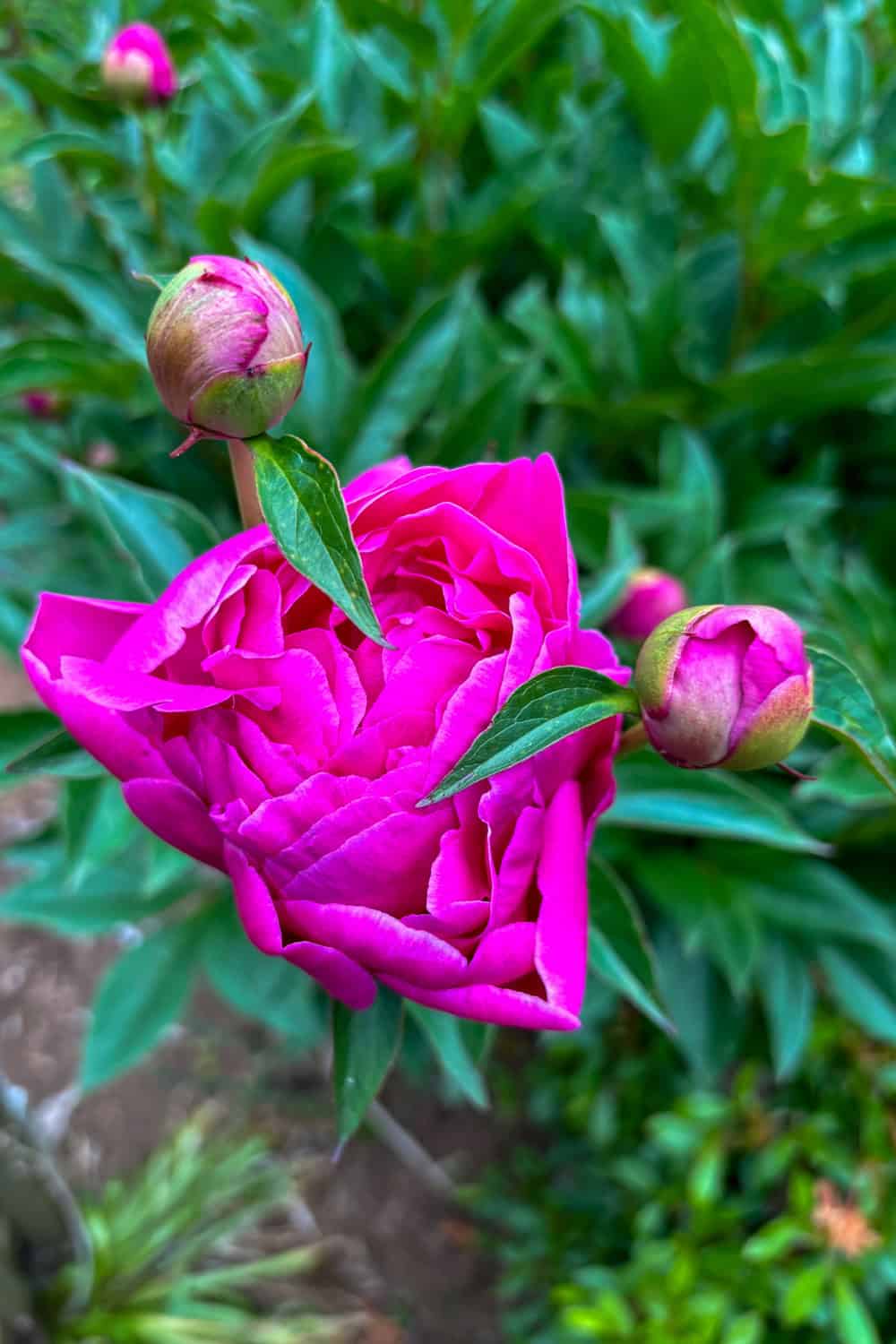
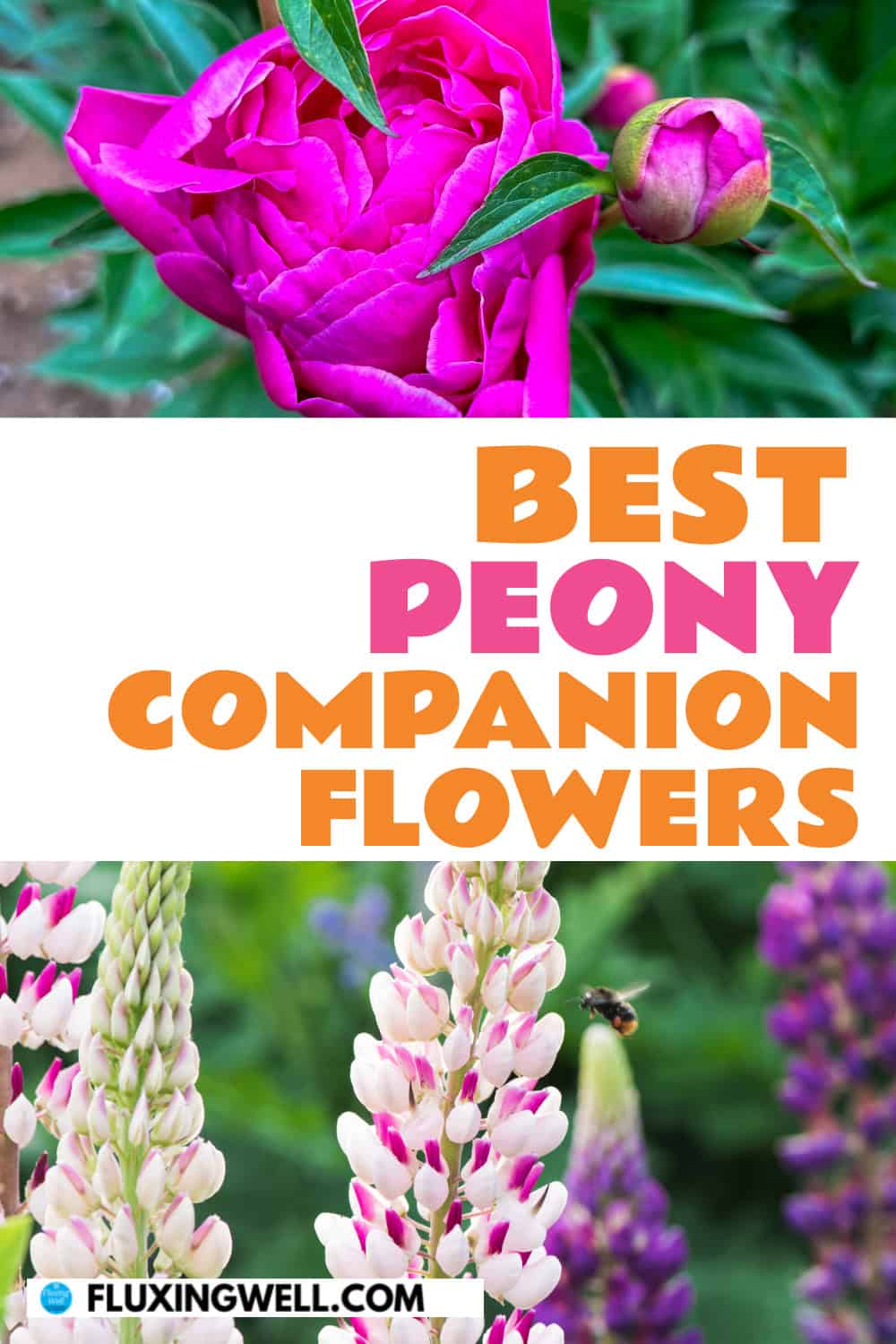
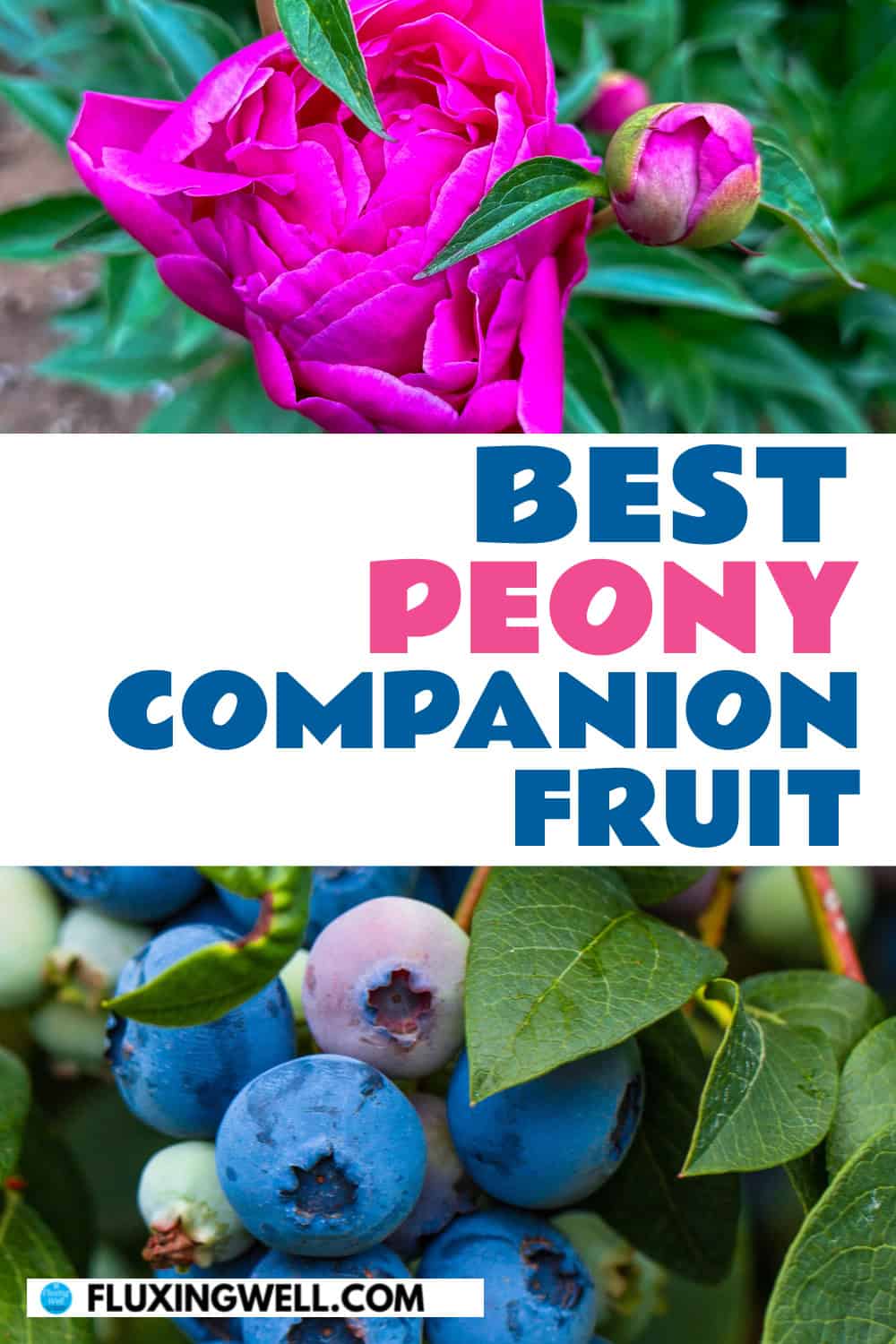
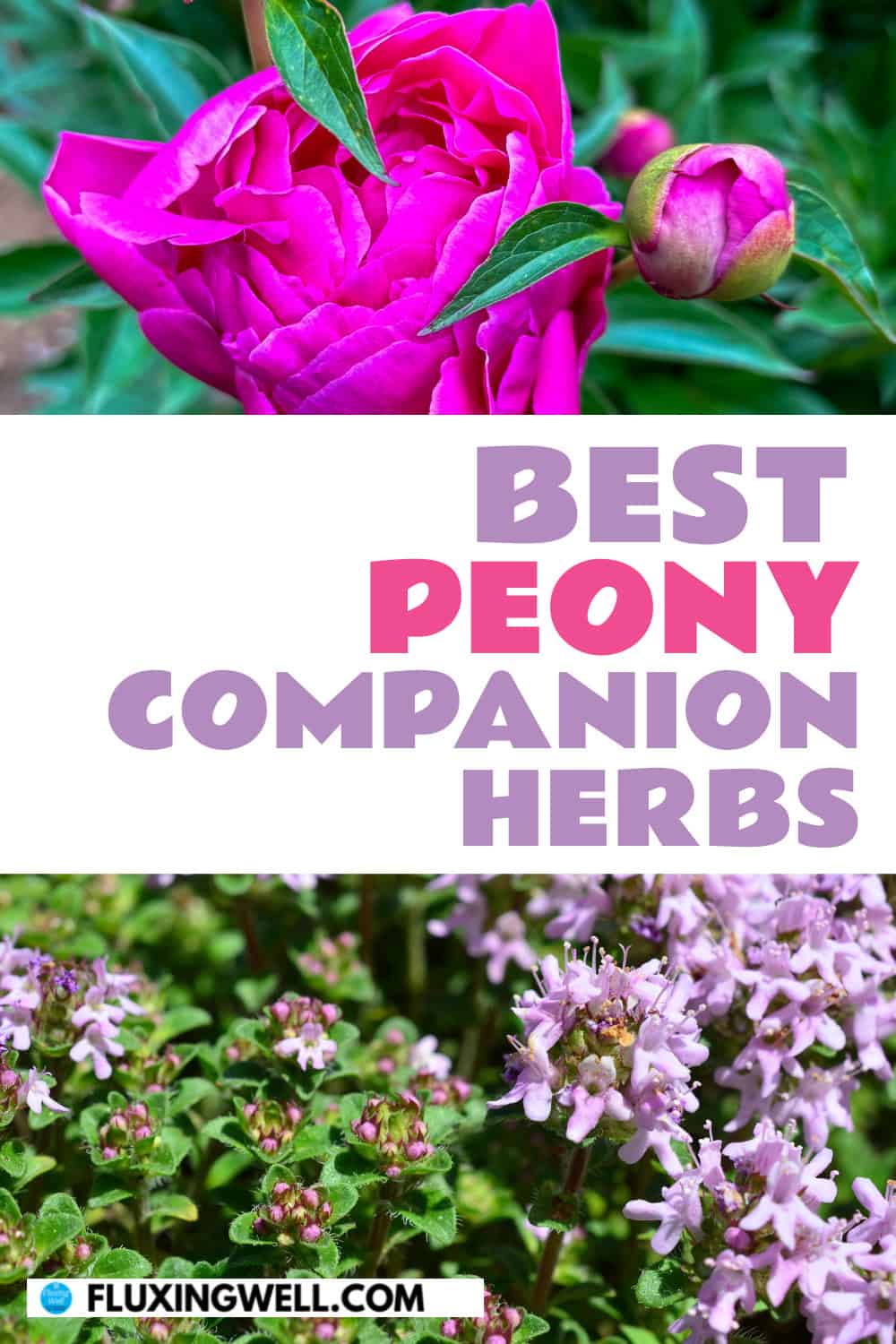
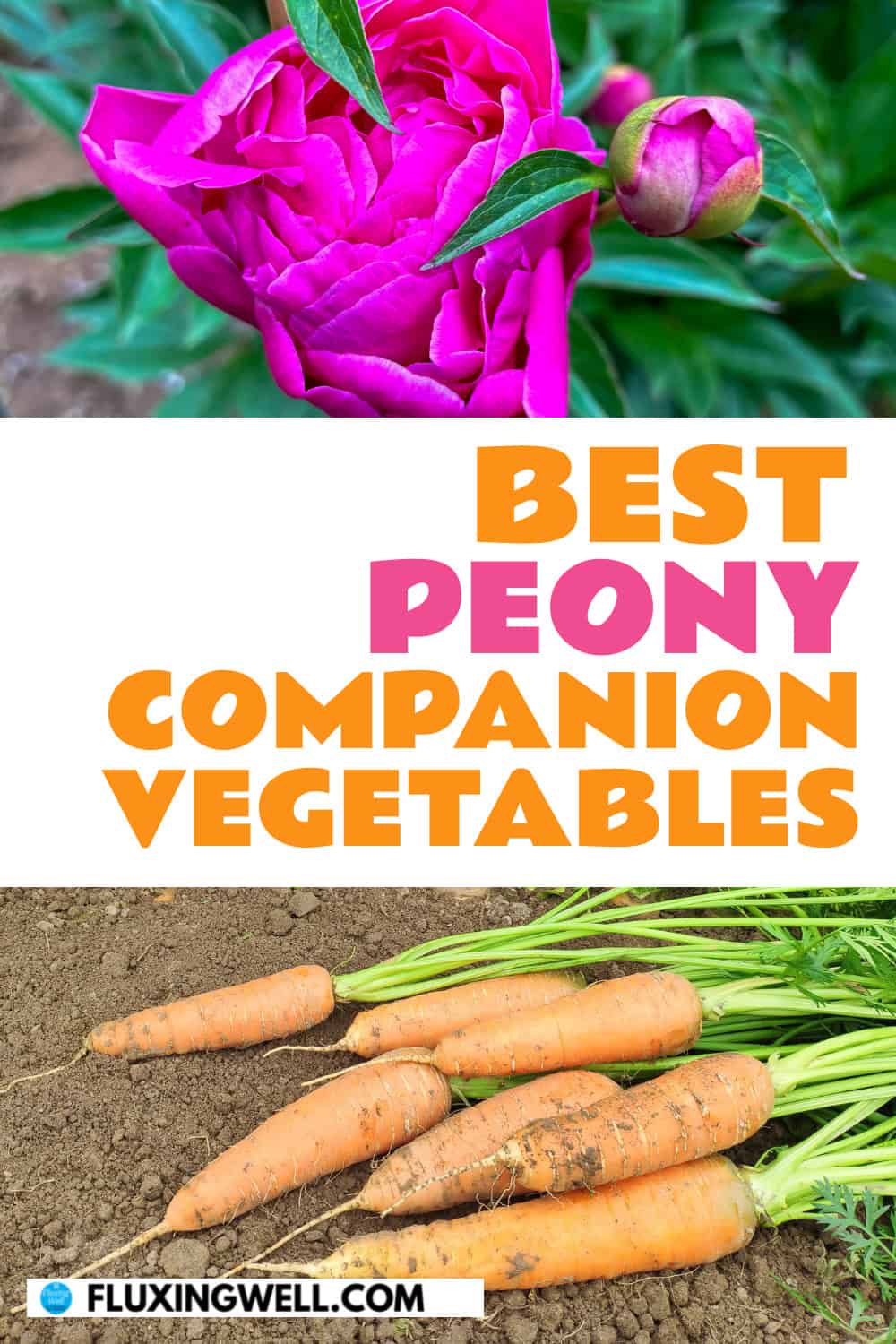

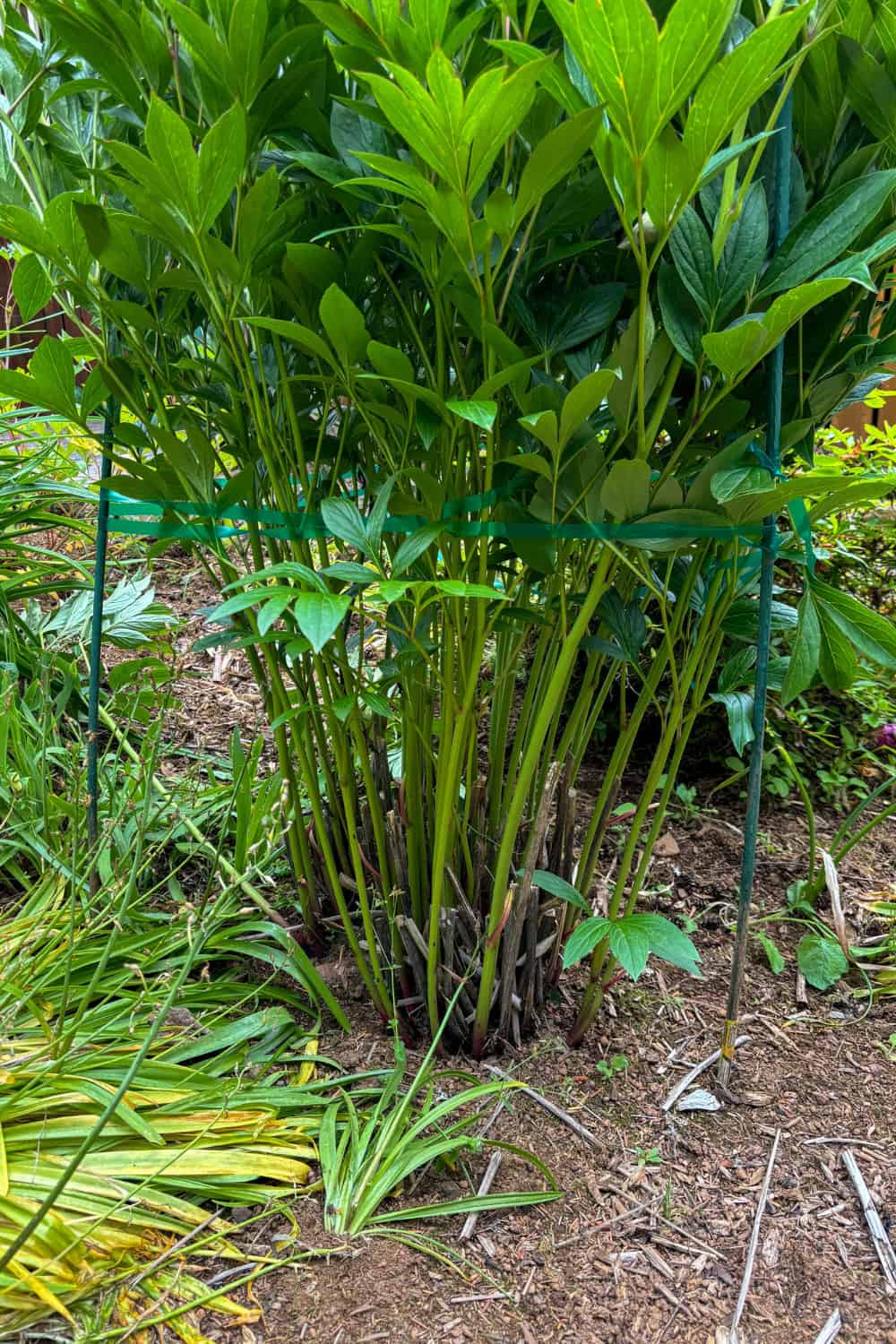
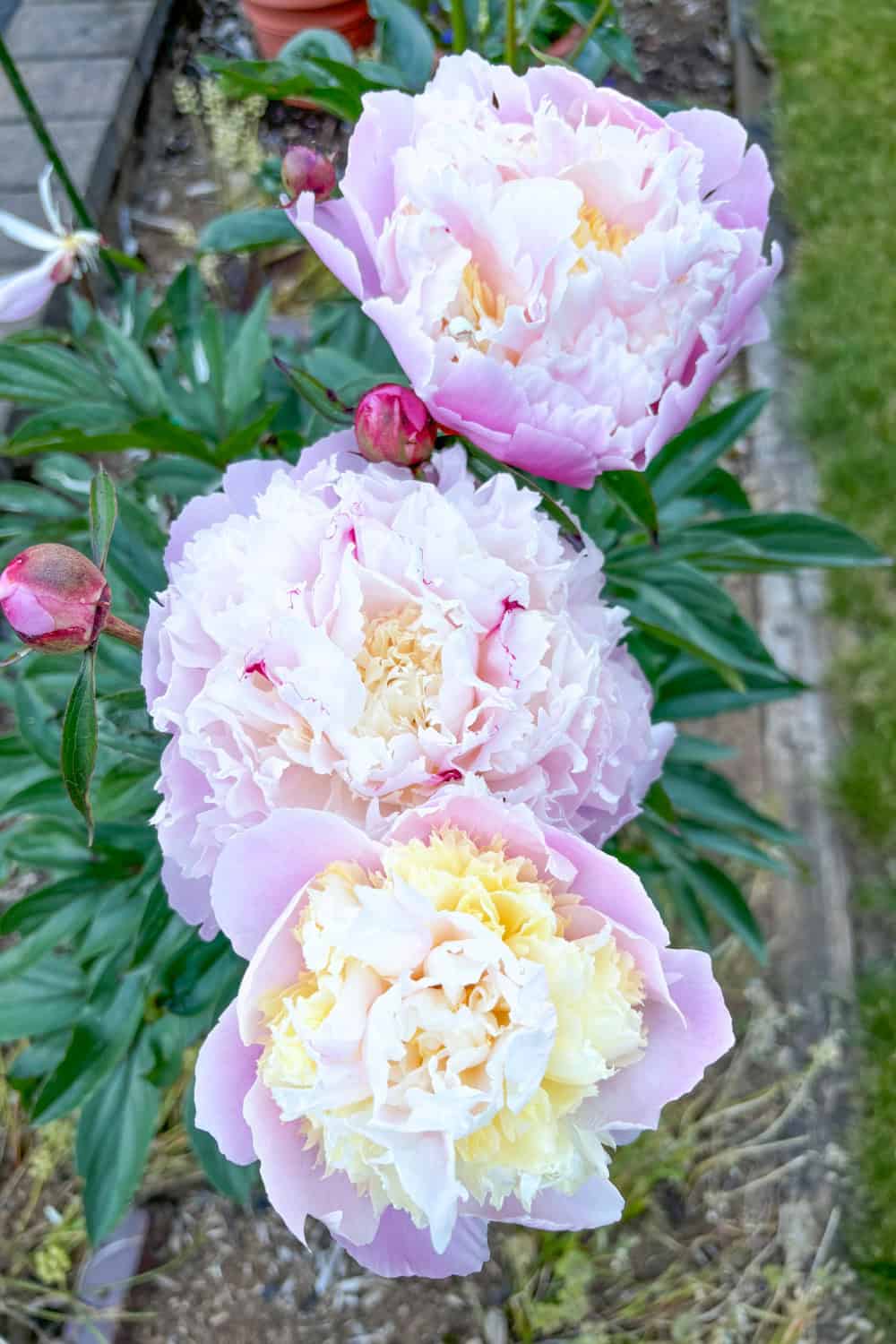


Thank you for the great information for the best peony companion plants. I appreciate all the great growing tips included as well.
You are most welcome! Peonies make excellent cut flower bouquets and are such a cheery flower.
Your information on peony companion plants is so helpful and thorough! I live in Indiana, where our state flower is the peony. I can better care for my plant now.😁
I did not know the Indiana state flower is the peony. Thank you for expanding my knowledge. Happy peony-growing!